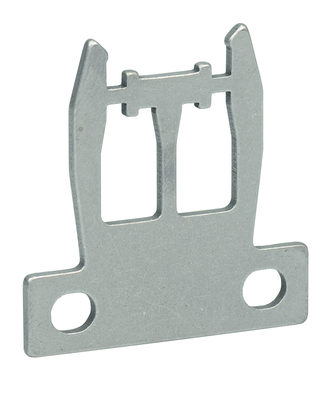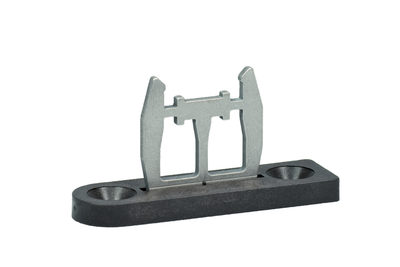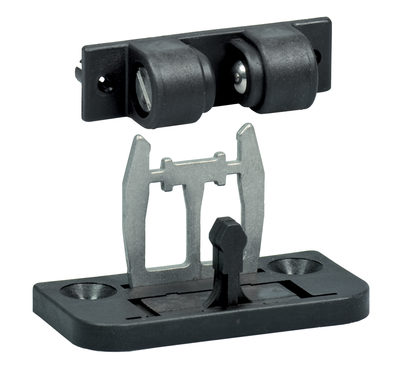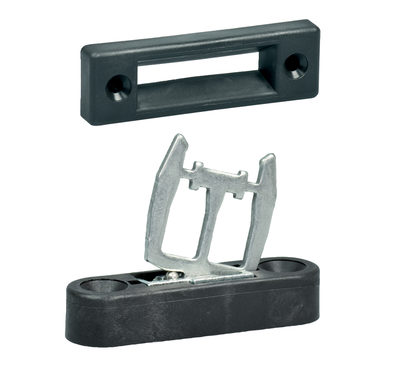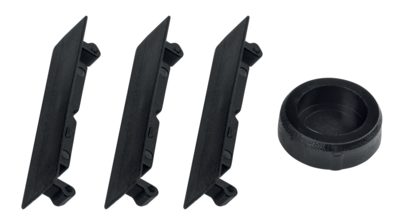AZM 161SK-12/12RKTU-024
AZM 161SK-12/12RKTU-024
| Désignation produit: AZM161 (1)-(2)(3)K(4)-(5)/(6)-(7)(8) |
| (1) | |
| SK | Bornes à vis |
| CC | Bornes à ressort |
| ST | Connecteur M12 |
| (2) | |
| 11/03 | Bobine: 1 contact NO, 1 contact NF / interrupteur: 3 contacts NF avec connecteur intégré |
| 12/03 | Bobine: 1 contact NO, 2 contacts NF / interrupteur: 3 contacts NF |
| 12/11 | Bobine: 1 contact NO, 2 contact NF / interrupteur: 1 contact NO, 1 contacts NF avec connecteur intégré |
| 11/12 | Bobine: 1 contact NO, 1 contact NF / interrupteur: 1 contact NO, 2 contacts NF avec connecteur intégré |
| 12/12 | Bobine: 1 contact NO, 2 contacts NF / interrupteur: 1 contact NO, 2 contacts NF |
| (3) | |
| Sans | Force de maintien 5 N |
| R | Force de maintien 30 N |
| (4) | |
| Sans | Ouverture sous tension |
| A | Ouverture hors tension |
| (5) | |
| Sans | Déverrouillage manuel latéral |
| ED | Déverrouillage manuel côté couvercle |
| (6) | |
| T | Déverrouillage de secours latéral |
| TD | Déverrouillage de secours côté couvercle |
| TU | Déverrouillage d'urgence |
| (7) | |
| 024 | Us: 24 VAC/DC |
| 110/230 | Us: 110/230 VAC |
| (8) | |
| sans | sans LED |
| G | avec LED (seulement pour Us: 24 VAC/DC) |
- Grande chambre de raccordement
- Déverrouillage de secours, arrière
- entrées de câble 4 M 16 x 1.5
- Boîtier plastique
- Double isolation
- Interverrouillage avec protection contre les défauts de fermeture
- 130 mm x 90 mm x 30 mm
- 6 Contacts
- Durée de vie élevée
Exemple de commande
| Désignation de type du produit |
AZM 161SK-12/12RKTU-024 |
| Référence d’article (n° de commande) |
101187849 |
| EAN (European Article Number) |
4030661357171 |
| eCl@ss number, version 12.0 |
27-27-26-03 |
| eCl@ss number, version 11.0 |
27-27-26-03 |
| Numéro eCl@ss, version 9.0 |
27-27-26-03 |
| ETIM number, version 7.0 |
EC002593 |
| ETIM number, version 6.0 |
EC002593 |
Homologations - Règlementations
|
IFA cULus CCC |
Caractéristiques globales
| Règlementations |
EN ISO 13849-1 EN ISO 14119 EN IEC 60947-5-1 |
| Codage selon EN ISO 14119 |
faible |
| Mode d’action |
électromécanique |
| Matériau du boîtier |
Plastique, thermoplastique renforcé de fibres de verre, auto-extinguible |
| Poids brut |
434 g |
Données générales - Caractéristiques
| Ouverture sous tension |
Oui |
| Déverrouillage de secours |
Oui |
| déverrouillage manuel |
Oui |
| Nombre de directions d'approche |
3 |
| Nombre de contacts auxiliaires |
2 |
| Nombre de contacts de sécurité |
4 |
Classification
| Normes de référence |
EN ISO 13849-1 |
| Performance Level, jusqu'à |
c |
| Catégorie selon EN ISO 13849 |
1 |
| B10D Normally-closed contact (NC) |
2.000.000 manœuvres |
| Note |
Electrical life on request. |
| B10D Normally-open contact (NO) |
1.000.000 manœuvres |
| Note |
at 10% Ie and ohmic load |
| Durée d'utilisation |
20 année(s) |
Classification de sécurité - Exclusion de défauts
| Attention: |
Utilisable si l'exclusion d'une défaillance dangereuse de la mécanique à 1 canal est autorisée et si une protection antifraude suffisante est garantie. |
| Performance Level, jusqu'à |
d |
| Catégorie selon EN ISO 13849 |
3 |
| Note |
for 2-channel use and with suitable logic unit. |
| Durée d'utilisation |
20 année(s) |
Classification de sécurité - Fonction de verrouillage
| Performance Level, jusqu'à |
e |
| Note (Performance Level) |
Information for the safety classification of the guard locking function is documented in the "Operating instructions" or in the "Operation and mounting" instructions. |
Données mécaniques
| Durée de vie mécanique, min. |
1.000.000 manœuvres |
| Jeu de l'actionneur dans la direction d'actionnement |
5,5 mm |
| Force de retenue conforme à la norme EN ISO 14119 |
2.000 N |
| Force de retenue, max. |
2.600 N |
| force de maintien |
30 N |
| course d'ouverture forcée |
10 mm |
| Positive break force per NC contact, minimum |
10 N |
| Force d'ouverture forcée, min. |
20 N |
| Vitesse d'attaque, max. |
2 m/s |
| Fixation |
Vis |
| Exécution des vis de fixation |
3x M5 |
| Type of the screw head |
Flat head screw |
| Tightening torque of the fastening screws for the housing cover |
0,6 Nm |
| Note |
The tightening sequence of the cover screws must be observed. This can be found in the attached drawing in the “Pictures” tab. |
Données mécaniques – technique de connexion
| Entrée de câble |
4 x M16 x 1,5 |
| Connecteur de raccordement |
Bornes à vis |
| Section du câble, min. |
0,25 mm² |
| Section du câble, max. |
1,5 mm² |
| Remarque (section du câble) |
Toutes les indications relatives à la section du câble sont embouts compris. |
| Allowed type of cable |
solid single-wire solid multi-wire flexible |
Données mécaniques - Dimensions
| Longueur du capteur |
30 mm |
| Largeur du capteur |
130 mm |
| Hauteur du capteur |
90 mm |
Conditions ambiantes
| Etanchéité |
IP67 |
| Ambient temperature |
-30 ... +60 °C |
| Storage and transport temperature |
-30 ... +85 °C |
| Remarque (humidité relative) |
sans condensation non givrant |
| Degré de protection |
II |
| Hauteur d'installation autorisée au-dessus de NN, maximum |
2.000 m |
Conditions ambiantes - Valeur d'isolation
| Tension assignée d'isolement |
250 VAC |
| Tension assignée de tenue aux chocs |
4 kV |
Données électriques
| Courant nominal thermique |
6 A |
| Tension assignée d'alimentation |
24 VAC/DC |
| Courant de court-circuit nominal selon EN 60947-5-1 |
1.000 A |
| Consommation électrique, max. |
10 W |
| Elément de commutation |
Contact NO, contact NF |
| Principe de commutation |
slow action, positive break NC contact |
| Fréquence de manœuvres |
1.000 /h |
| Matériau des contacts, électriques |
Argent |
Données électriques - Commande de l'électroaimant IN
| Magnet switch-on time |
100 % |
| Test pulse duration, maximum |
5 ms |
| Test pulse interval, minimum |
50 ms |
Données électriques - Contacts de sécurité
| Tension, catégorie d'utilisation AC-15 |
230 VAC |
| Courant, catégorie d'utilisation AC-15 |
4 A |
| Tension, catégorie d'utilisation DC-13 |
24 VDC |
| Courant, catégorie d'utilisation DC-13 |
2,5 A |
Données électriques - Contacts auxiliaires
| Tension, catégorie d'utilisation AC-15 |
230 VAC |
| Courant, catégorie d'utilisation AC-15 |
4 A |
| Tension, catégorie d'utilisation DC-13 |
24 VDC |
| Courant, catégorie d'utilisation DC-13 |
2,5 A |
Données diverses
| Remarque (applications) |
protecteur coulissant protecteur amovible protecteur pivotant |
Inclus dans la livraison
| Inclus dans la livraison |
Actuator must be ordered separately. |
Remarque
| Remarque (déverrouillage de secours) |
le déverrouillage de secours est utilisé aux endroits où une intervention dans une zone dangereuse déjà verrouillée est nécessaire Déverrouillage de secours par enfoncement du bouton coup-de-poing rouge Réarmement par traction sur le bouton coup-de-poing Montage du côté couvercle (suffixe de commande -TD) ou en arrière (suffixe de commande -TU) possible |
| Remarque (déverrouillage de secours, déverrouillage manuel électrique) |
Une combinaison de déverrouillage manuel et de déverrouillage de secours avec différentes directions de montage est uniquement possible pour les variantes suivantes: -ED/-TU et -TD/-EU |
Filtre de langue
Fiches techniques
Mode d'emploi et déclaration de conformité (courte)
Certificat UL
Certificat DGUV
Certification CCC
Information client
Bibliothèque/Library SISTEMA-VDMA
Télécharger la dernière version d'Adobe Reader
Photo du produit (photo individuelle de catalogue)
Plan d'encombrement composant de base
Plan d'encombrement composant de base
Plan d'encombrement divers
Diagramme des contacts
Diagramme de contact
Table des matières
- 1 A propos de ce document
- 1.1 Fonction
- 1.2 Groupe cible pour le mode d'emploi : personnel qualifié et autorisé
- 1.3 Symboles utilisés
- 1.4 Définition de l'application
- 1.5 Consignes de sécurité générales
- 2 Description du produit
- 2.1 Exemple de commande
- 2.2 Versions spéciales
- 2.3 Destination et emploi
- 2.4 Avertissement en cas de mauvaise utilisation
- 2.5 Clause de non-responsabilité
- 2.6 Données techniques
- 3 Montage
- 3.1 Instructions de montage générales
- 3.2 Dimensions
- 3.3 déverrouillage manuel
- 3.4 Déverrouillage d’urgence (indice de commande –N)
- 3.5 Déverrouillage de secours
- 4 Raccordement électrique
- 4.1 Notes générales pour le raccordement électrique
- 4.2 Variantes de contact
- 5 Mise en service et maintenance
- 6 Démontage et mise au rebut
- 6.1 Démontage
- 6.2 Mise au rebut
1 A propos de ce document
1.1 Fonction
Le présent document fournit les informations nécessaires au montage, à la mise en service, au fonctionnement sûr ainsi qu'au démontage du dispositif de sécurité. Il est important de conserver le mode d'emploi joint à l'appareil à tout moment en condition lisible et accessible .
1.2 Groupe cible pour le mode d'emploi : personnel qualifié et autorisé
Toutes les manipulations sur l'appareil indiquées dans cette notice ne doivent être effectuées que par un personnel qualifié, spécialisé et autorisé par l'exploitant de l'installation.
Il est important de lire et de comprendre le mode d'emploi avant l'installation et la mise en service du composant. Vous devez également connaître les prescriptions en vigueur concernant la sécurité du travail et la prévention des accidents.
Pour le choix et le montage des composants ainsi que leur intégration dans le circuit de commande, le constructeur de machines doit observer les exigences des directives et des règlements en vigueur.
Les caractéristiques et recommandations figurant dans ce document sont exclusivement données à titre d’information et sans engagement contractuel de notre part.
1.3 Symboles utilisés
- Informations, remarques: En suivant ce symbole, vous trouverez des informations complémentaires très utiles.
- Attention: Le non-respect de cette recommandation peut entraîner des pannes ou des défauts de fonctionnement.
Avertissement: Le non-respect de cette instruction peut entraîner des blessures physiques et/ou des dommages machine.
1.4 Définition de l'application
La gamme de produits Schmersal n'est pas destinée aux particuliers
Les produits décrits dans ce mode d'emploi ont été développés pour réaliser des fonctions relatives à la sécurité comme partie intégrante d'une machine ou d'une installation. La responsabilité du fonctionnement correct de l'ensemble de l'installation incombe au fabricant de la machine.
Le dispositif de sécurité ne doit être utilisé que dans les dispositions suivantes ou pour les applications autorisées par le fabricant. Le champ d'application est décrit en détail dans le chapitre "Description du produit".
1.5 Consignes de sécurité générales
Les consignes de sécurité de ce mode d'emploi, les standards d'installation spécifiques du pays concerné ainsi que les dispositions de sécurité et les règles de prévention d'accidents sont à observer.
- Pour toute autre information technique, veuillez vous référer aux catalogues Schmersal ou à notre catalogue en ligne products.schmersal.com.
2 Description du produit
2.1 Exemple de commande
| Désignation produit: AZM161 (1)-(2)(3)K(4)-(5)/(6)-(7)(8) |
| (1) | |
| SK | Bornes à vis |
| CC | Bornes à ressort |
| ST | Connecteur M12 |
| (2) | |
| 11/03 | Bobine: 1 contact NO, 1 contact NF / interrupteur: 3 contacts NF avec connecteur intégré |
| 12/03 | Bobine: 1 contact NO, 2 contacts NF / interrupteur: 3 contacts NF |
| 12/11 | Bobine: 1 contact NO, 2 contact NF / interrupteur: 1 contact NO, 1 contacts NF avec connecteur intégré |
| 11/12 | Bobine: 1 contact NO, 1 contact NF / interrupteur: 1 contact NO, 2 contacts NF avec connecteur intégré |
| 12/12 | Bobine: 1 contact NO, 2 contacts NF / interrupteur: 1 contact NO, 2 contacts NF |
| (3) | |
| Sans | Force de maintien 5 N |
| R | Force de maintien 30 N |
| (4) | |
| Sans | Ouverture sous tension |
| A | Ouverture hors tension |
| (5) | |
| Sans | Déverrouillage manuel latéral |
| ED | Déverrouillage manuel côté couvercle |
| (6) | |
| T | Déverrouillage de secours latéral |
| TD | Déverrouillage de secours côté couvercle |
| TU | Déverrouillage d'urgence |
| (7) | |
| 024 | Us: 24 VAC/DC |
| 110/230 | Us: 110/230 VAC |
| (8) | |
| sans | sans LED |
| G | avec LED (seulement pour Us: 24 VAC/DC) |
2.2 Versions spéciales
Pour les versions spéciales, qui ne sont pas reprises dans l'exemple de commande, les indications de ce mode d'emploi s'appliquent dans la mesure où ces modèles concordent avec les versions de série.
2.3 Destination et emploi
Le dispositif d‘interverrouillage assure, en liaison avec la commande de la machine, qu’un protecteur mobile ne puisse être ouvert tant que les mouvements dangereux ne sont pas terminés.
- Les dispositifs d'interverrouillage à ouverture hors tension ne doivent être utilisés que dans des cas particuliers, après une minutieuse évaluation du risque, car lors d'une perte de l'alimentation électrique ou d'une coupure par le sectionneur principal, le dispositif de protection peut être ouvert immédiatement.
- Les dispositifs de sécurité sont classifiés comme dispositifs de verrouillage de type 2 selon EN ISO 14119.
- L’utilisateur doit évaluer et concevoir la chaîne de sécurité conformément aux normes applicables et en fonction du niveau de sécurité requis.
- L'ensemble du système de commande, dans lequel le composant de sécurité est intégré, doit être validé selon les normes pertinentes.
2.4 Avertissement en cas de mauvaise utilisation
- En cas d'emploi non-conforme, non-approprié ou en cas de manipulations frauduleuses, l'utilisation de l'appareil est susceptible d'entraîner des dommages pour l'homme ou des dégâts matériels. Aucun risque résiduel affectant la sécurité n'est connu, si les consignes de sécurité, les instructions de montage, de mise en service, de fonctionnement et d'entretien de ce mode d'emploi ont été respectés.
2.5 Clause de non-responsabilité
Nous déclinons toute responsabilité en cas de montage erroné ou de non-observation des instructions de ce mode d'emploi. Nous déclinons également les dommages en cas d' utilisation de pièces détachées ou d' accessoires non-autorisées par le fabricant.
Pour des raisons de sécurité, il est strictement interdit de transformer ou modifier un dispositif de sécurité de sa propre initiative. Le fabricant ne peut être tenu responsable des dommages qui en découleraient
2.6 Données techniques
Homologations - Règlementations
|
IFA cULus CCC |
Caractéristiques globales
| Règlementations |
EN ISO 13849-1 EN ISO 14119 EN IEC 60947-5-1 |
| Codage selon EN ISO 14119 |
faible |
| Mode d’action |
électromécanique |
| Matériau du boîtier |
Plastique, thermoplastique renforcé de fibres de verre, auto-extinguible |
| Poids brut |
434 g |
Données générales - Caractéristiques
| Ouverture sous tension |
Oui |
| Déverrouillage de secours |
Oui |
| déverrouillage manuel |
Oui |
| Nombre de directions d'approche |
3 |
| Nombre de contacts auxiliaires |
2 |
| Nombre de contacts de sécurité |
4 |
Classification
| Normes de référence |
EN ISO 13849-1 |
| Performance Level, jusqu'à |
c |
| Catégorie selon EN ISO 13849 |
1 |
| B10D Normally-closed contact (NC) |
2.000.000 manœuvres |
| Note |
Electrical life on request. |
| B10D Normally-open contact (NO) |
1.000.000 manœuvres |
| Note |
at 10% Ie and ohmic load |
| Durée d'utilisation |
20 année(s) |
Classification de sécurité - Exclusion de défauts
| Attention: |
Utilisable si l'exclusion d'une défaillance dangereuse de la mécanique à 1 canal est autorisée et si une protection antifraude suffisante est garantie. |
| Performance Level, jusqu'à |
d |
| Catégorie selon EN ISO 13849 |
3 |
| Note |
for 2-channel use and with suitable logic unit. |
| Durée d'utilisation |
20 année(s) |
Classification de sécurité - Fonction de verrouillage
| Performance Level, jusqu'à |
e |
| Note (Performance Level) |
Information for the safety classification of the guard locking function is documented in the "Operating instructions" or in the "Operation and mounting" instructions. |
Données mécaniques
| Durée de vie mécanique, min. |
1.000.000 manœuvres |
| Jeu de l'actionneur dans la direction d'actionnement |
5,5 mm |
| Force de retenue conforme à la norme EN ISO 14119 |
2.000 N |
| Force de retenue, max. |
2.600 N |
| force de maintien |
30 N |
| course d'ouverture forcée |
10 mm |
| Positive break force per NC contact, minimum |
10 N |
| Force d'ouverture forcée, min. |
20 N |
| Vitesse d'attaque, max. |
2 m/s |
| Fixation |
Vis |
| Exécution des vis de fixation |
3x M5 |
| Type of the screw head |
Flat head screw |
| Tightening torque of the fastening screws for the housing cover |
0,6 Nm |
| Note |
The tightening sequence of the cover screws must be observed. This can be found in the attached drawing in the “Pictures” tab. |
Données mécaniques – technique de connexion
| Entrée de câble |
4 x M16 x 1,5 |
| Connecteur de raccordement |
Bornes à vis |
| Section du câble, min. |
0,25 mm² |
| Section du câble, max. |
1,5 mm² |
| Remarque (section du câble) |
Toutes les indications relatives à la section du câble sont embouts compris. |
| Allowed type of cable |
solid single-wire solid multi-wire flexible |
Données mécaniques - Dimensions
| Longueur du capteur |
30 mm |
| Largeur du capteur |
130 mm |
| Hauteur du capteur |
90 mm |
Conditions ambiantes
| Etanchéité |
IP67 |
| Ambient temperature |
-30 ... +60 °C |
| Storage and transport temperature |
-30 ... +85 °C |
| Remarque (humidité relative) |
sans condensation non givrant |
| Degré de protection |
II |
| Hauteur d'installation autorisée au-dessus de NN, maximum |
2.000 m |
Conditions ambiantes - Valeur d'isolation
| Tension assignée d'isolement |
250 VAC |
| Tension assignée de tenue aux chocs |
4 kV |
Données électriques
| Courant nominal thermique |
6 A |
| Tension assignée d'alimentation |
24 VAC/DC |
| Courant de court-circuit nominal selon EN 60947-5-1 |
1.000 A |
| Consommation électrique, max. |
10 W |
| Elément de commutation |
Contact NO, contact NF |
| Principe de commutation |
slow action, positive break NC contact |
| Fréquence de manœuvres |
1.000 /h |
| Matériau des contacts, électriques |
Argent |
Données électriques - Commande de l'électroaimant IN
| Magnet switch-on time |
100 % |
| Test pulse duration, maximum |
5 ms |
| Test pulse interval, minimum |
50 ms |
Données électriques - Contacts de sécurité
| Tension, catégorie d'utilisation AC-15 |
230 VAC |
| Courant, catégorie d'utilisation AC-15 |
4 A |
| Tension, catégorie d'utilisation DC-13 |
24 VDC |
| Courant, catégorie d'utilisation DC-13 |
2,5 A |
Données électriques - Contacts auxiliaires
| Tension, catégorie d'utilisation AC-15 |
230 VAC |
| Courant, catégorie d'utilisation AC-15 |
4 A |
| Tension, catégorie d'utilisation DC-13 |
24 VDC |
| Courant, catégorie d'utilisation DC-13 |
2,5 A |
Données diverses
| Remarque (applications) |
protecteur coulissant protecteur amovible protecteur pivotant |
Remarques concernant la classification de sécurité:
- Classification de sécurité de la fonction d'interverrouillage
De façon générale, utilisable jusqu'à cat. 1 / PL c.
En cas d'utilisation de 2 canaux et exclusion de défauts mécaniques (si une exclusion de défauts pour la mécanique à 1 canal est autorisée) et module de sécurité approprié, jusqu'à cat. 3 / PL d.

(Les valeurs indiquées peuvent varier en fonction des paramètres spécifiques de l'application hop, dop et tcycle ainsi que de la charge.)
Lorsque plusieurs composants de sécurité sont connectés en série, le Niveau de Performance PL selon EN ISO 13849-1 peut être dégradé dans certaines conditions, parce que la qualité du diagnostic des défauts s'est réduite.
- Classification de sécurité de la fonction de verrouillage
Si l'appareil est utilisé comme dispositif de verrouillage pour la protection de l'homme, une classification de sécurité de la fonction de verrouillage est requise. La sécurité d'un interverrouillage est classifiée de 2 manières: on distingue entre la surveillance de la fonction de verrouillage (blocage du protecteur) et la commande de la fonction de déverrouillage. La classification de sécurité suivante de la fonction de déverrouillage est basée sur la coupure sûre de l'alimentation de l'électroaimant.
- La classification de sécurité de la fonction de déverrouillage est uniquement valable pour les appareils avec fonction de verrouillage surveillée et avec ouverture sous tension (voir code de commande).
En coupant l'alimentation électrique par l'extérieur de façon sûre, les défauts de blocage du dispositif d'interverrouillage peuvent être exclus. Dans ce cas, le blocage du dispositif d'interverrouillage ne contribue pas à la probabilité de défaillance de la fonction de déverrouillage. Le niveau de sécurité de la fonction de déverrouillage est donc uniquement déterminé par le système de coupure externe sûre de l'alimentation électrique.

| Légende | |
|---|---|
| ¢ | Coupure sûre de l'alimentation électrique |
| ƒ | Interverrouillage de sécurité |
| ¥ | Fonction d'interverrouillage |
- Les exclusions de défauts pour la pose des câbles sont à observer.
- Si un interverrouillage avec ouverture sous tension ne peut pas être utilisé pour l'application, un interverrouillage avec ouverture hors tension peut exceptionnellement être utilisé, à condition que des mesures de sécurité supplémentaires soient appliquées pour réaliser un niveau de sécurité équivalent.
Remarque UL
- Utilisez des connecteurs de type 4X (pour l'intérieur) et 12. Couple de serrage: 4,4 lb in.
3 Montage
3.1 Instructions de montage générales
- Veuillez observer les remarques des normes EN ISO 12100, EN ISO 14119 et EN ISO 14120.
Trois trous de montage sont prévus pour fixer le boîtier. La connexion à la terre n'est donc pas autorisée. La connexion à la terre n'est donc pas autorisée. L'interverrouillage de sécurité ne doit pas servir de butée mécanique. La position de montage est indifférente. Elle doit toutefois être choisie de manière à ce que la pénétration de saletés dans l'ouverture utilisée soit empêchée. Les ouvertures non-utilisées par l'actionneur doivent être obturées au moyen d'obturateurs.
- L'actionneur doit être fixé sur le protecteur de manière indémontable (vis indémontables, collage, perçage des têtes de vis, goupillage) et est à protéger contre le décalage.
3.2 Dimensions
Toutes les dimensions sont indiquées en mm.

3.3 déverrouillage manuel
(en cas d' ajustage, d' entretien, etc.)
Pour réaliser un déverrouillage manuel, tournez la clé triangulaire M5 de 180° (disponible comme accessoire) jusqu' à ce que le pêne d'interverrouillage soit poussé en position déverrouillée. Il faut veiller à ce que tout blocage soit évité par des influences extérieures agissant sur l'actionneur. La fonction normale de l'interverrouillage est seulement rétablie après que la clé triangulaire soit ramenée en position de départ. Après la mise en service, le déverrouillage manuel doit être obturé au moyen du capuchon plastique inclus dans la livraison.
| Déverrouillage manuel latéral | Déverrouillage manuel côté couvercle ou côté arrière (indice de commande –ED/-EU) |
 |  |
La clef triangulaire TK-M5 (101100887) est disponible comme accessoire.
3.4 Déverrouillage d’urgence (indice de commande –N)
(Montage et actionnement uniquement à l'extérieur de la zone dangereuse)
- Le déverrouillage d'urgence ne doit être utilisé qu'en cas d'urgence. L'interverrouillage de sécurité doit être installé et/ou protégé de telle sorte qu'une ouverture intempestive de l'interverrouillage via le levier de déverrouillage d'urgence soit évitée. Il faut apposer une indication claire sur le déverrouillage d'urgence qu'il ne doit être utilisé qu'en cas d'urgence. A cet effet, l'autocollant compris dans la livraison peut être utilisé.
Afin de réaliser un déverrouillage d'urgence, tournez le levier orange dans la direction indiquée par la flèche jusqu'à la butée. Le protecteur peut être ouvert dans cette position. Le levier s'encliquette dans cette position et il n'est pas possible de le retourner. Pour enlever le blocage, il faut dévisser la vis de fixation centrale jusqu'à ce que le blocage soit enlevé. Le levier doit être ramené dans sa position initiale et la vis doit être resserrée.
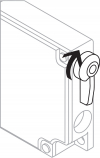
3.5 Déverrouillage de secours
(Montage et actionnement uniquement à l'intérieur de la zone dangereuse)
Pour réaliser un déverrouillage de secours avec la version T, tournez le levier orange dans la direction indiquée par la flèche jusqu'à la butée. Le déverrouillage de secours des versions TD et TU est réalisé en appuyant sur le bouton coup-de-poing rouge. Le protecteur peut être ouvert dans cette position. Le blocage est enlevé en tournant le levier dans le sens inverse ou en tirant le coup-de-poing dans sa position initiale. En position déverrouillée, le protecteur est protégé contre toute fermeture intempestive.
| Déverrouillage de secours latéral (indice de commande –T) | Déverrouillage de secours côté couvercle ou côté arrière (indice de commande –TD/-TU) |
 |  |
4 Raccordement électrique
4.1 Notes générales pour le raccordement électrique
- Le raccordement électrique est à effectuer uniquement hors tension par du personnel compétent et qualifié.
- Si l'analyse de risques exige un interverrouillage de sécurité avec surveillance du protecteur verrouillé , les contacts marqués par le symbole > doivent être intégrés dans le circuit de sécurité.
Pour l'entrée de câble, des presse-étoupe avec un indice de protection approprié sont à utiliser. Les trous de fixation sont défoncés en vissant le presse-étoupe. Tous les résidus plastiques doivent être retirés de l'appareil.

- Veillez à ne pas endommager l'appareil avec les outils utilisés (p.ex. tournevis) lors du défonçage des entrées de câble.
Longueur x du fil dénudé:
- aux bornes à ressort (CC) du type s ou f: 5 ... 6 mm
- aux bornes à vis (SK): 7 mm
 |  |

4.2 Variantes de contact
Représentation des contacts hors tension et actionneur introduit.
| Ouverture sous tension | Ouverture hors tension |
|---|---|
| AZM 161SK-12/12... et AZM 161CC-12/12... | |
 |  |
| AZM 161SK-12/03... et AZM 161CC-12/03... | |
 |  |
| Légende | |
|---|---|
| B | Contact NF à manœuvre positive d'ouverture |
| > | Surveillance du protecteur verrouillé selon EN ISO 14119 |
| H | actionné |
| I | non actionné |
| AZM 161ST-../.. avec connecteur AZM 161ST-12/11... | AZM 161ST-11/12... |
 |  |
| AZM 161ST-11/03... | |
 |

Eléments de contacts 12/12 G (avec LED)

Le 24V est connecté en interne aux contacts 13 et 63. Les signaux correspondants aux indicateurs LED sont de plus disponibles aux bornes 14 ou 64.
Eléments de contacts 12/03 G (avec LED)

Le 24V est connecté en interne aux contacts 11 et 63. Les signaux correspondants aux indicateurs LED sont de plus disponibles aux bornes 12 ou 64.
| Légende | |
|---|---|
| ¢ | Protecteur fermé |
| ƒ | Aimant activé |
| ¥ | Protecteur verrouillé |
| Ouverture sous tension | ||||
|---|---|---|---|---|
| Etat du système | Commande de l'électro-aimant | LED | ||
| Ouverture sous tension | jaune ¢ | vert ƒ | jaune ¥ | |
| protecteur ouvert | 24 V (0 V) | éteinte | allumée | éteinte |
| Protecteur fermé, actionneur inséré, non verrouillé | 24 V | allumée | allumée | éteinte |
| Protecteur fermé, pêne inséré et verrouillé | 0 V | allumée | éteinte | allumée |
| Ouverture hors tension | ||||
|---|---|---|---|---|
| Etat du système | Commande de l'électro-aimant | LED | ||
| Ouverture hors tension | jaune ¢ | vert ƒ | jaune ¥ | |
| protecteur ouvert | 0 V (24 V) | éteinte | éteinte | éteinte |
| Protecteur fermé, actionneur inséré, non verrouillé | 0 V | allumée | éteinte | éteinte |
| Protecteur fermé, pêne inséré et verrouillé | 24 V | allumée | allumée | allumée |
5 Mise en service et maintenance
La fonction de sécurité du dispositif de sécurité doit être testée. En cas d'une installation correcte et d'une utilisation appropriée, le dispositif de sécurité ne nécessite aucun entretien. Nous recommandons une inspection visuelle et une vérification régulière selon les étapes suivantes:
- Vérification de la fixation de l’actionneur et du interrupteur de sécurité.
- Vérifier la fixation et l'intégrité des raccordements de câble.
- Enlèvement de la poussière et des encrassements.
- Dans toutes les phases de vie opérationnelles du dispositif de sécurité, des mesures antifraudes constructives et organisationnelles appropriées doivent être prises pour empêcher toute fraude du protecteur, par exemple au moyen d'un actionneur de remplacement.
- Remplacer les appareils endommagés ou défectueux.
6 Démontage et mise au rebut
6.1 Démontage
Le dispositif de sécurité doit être démonté uniquement hors tension.
6.2 Mise au rebut
- Le dispositif de sécurité doit être mis au rebut conformément aux prescriptions et législations nationales.
| UK Declaration of Conformity |  |
| Company: | K.A. Schmersal GmbH & Co. KG Möddinghofe 30 42279 Wuppertal Germany Internet: www.schmersal.com |
| Declaration: | We hereby, under sole responsibility, certify that the hereafter described components both in their basic design and construction conform to the relevant statutory requirements, regulations and designated standards of the United Kingdom. |
| Name of the component: | AZM 161 |
| Type: | See ordering code |
| Description of the component: | Interlocking device with electromagnetic interlock for safety functions |
| Relevant legislation: | Supply of Machinery (Safety) Regulations | 2008 |
| Electromagnetic Compatibility Regulations | 2016 | |
| The Restriction of the Use of Certain Hazardous Substances in Electrical and Electronic Equipment Regulations | 2012 |
| Designated standards: | EN 60947-5-1:2017 + AC:2020 EN ISO 14119:2013 |
| UK-Importer / Person authorised for the compilation of the technical documentation: | Schmersal UK Ltd. Paul Kenney Unit 1, Sparrowhawk Close Enigma Business Park Malvern, Worcestershire, WR14 1GL |
| Place and date of issue: | Wuppertal, August 23, 2023 |
 |
| Authorised signature Philip Schmersal Managing Director |
| Déclaration UE de conformité |  |
| Original | K.A. Schmersal GmbH & Co. KG Möddinghofe 30 42279 Wuppertal Germany Internet: www.schmersal.com |
| Déclaration: | Par la présente, nous certifions que les composants identifiés ci-après répondent de par leur conception et leur construction aux exigences des Directives Européennes applicables. |
| Désignation du composant | AZM 161 |
| Type: | voir exemple de commande |
| Description du composant: | Dispositif d'interverrouillage électromagnétique pour fonctions de sécurité |
| Directives pertinentes: | Directive Machines | 2006/42/CE |
| Directive CEM | 2014/30/EU | |
| Directive RoHS | 2011/65/EU |
| Normes appliquées: | EN 60947-5-1:2017 + AC:2020 EN ISO 14119:2013 |
| Représentant autorisé à préparer et composer la documentation technique: | Oliver Wacker Möddinghofe 30 42279 Wuppertal |
| Lieu et date de l'émission: | Wuppertal, 23 août 2023 |
 |
| Signature à l'effet d'engager la société Philip Schmersal Président Directeur Général |
Schmersal Schweiz AG, Moosmattstraße 3, 8905 Arni
Les données et les valeurs ont été soigneusement vérifiées. Les illustrations peuvent être différentes de l'original. Vous trouverez d'avantage de caractéristiques techniques dans les manuels d’instructions. Sous réserve de modifications techniques et errata.
Généré le: 13.10.2025 16:23
.png?id=a53583177d575b26b697294414b7f848)











